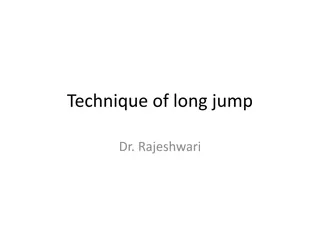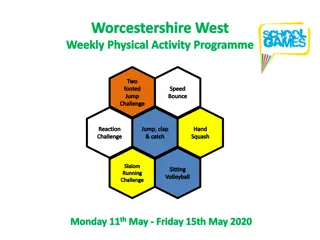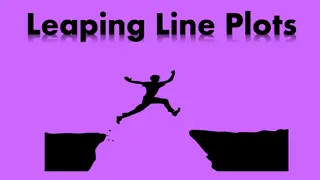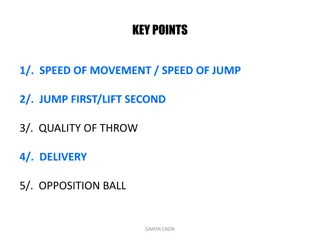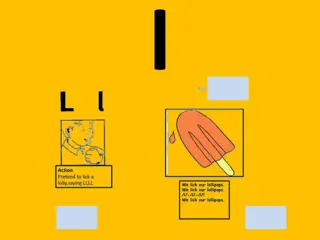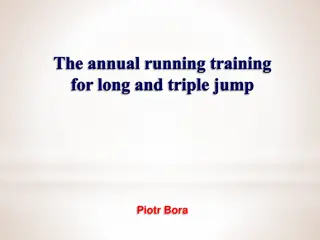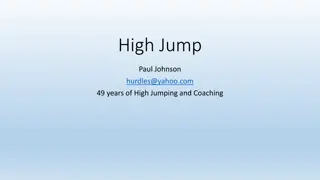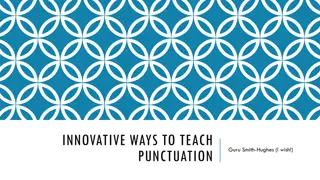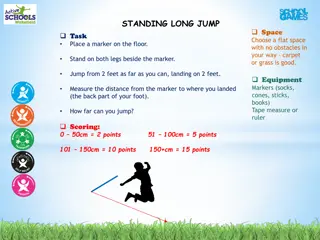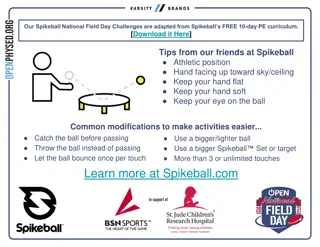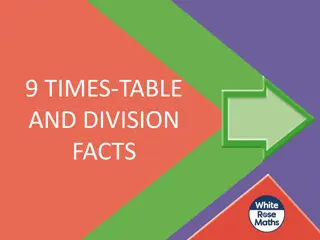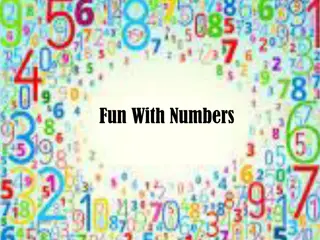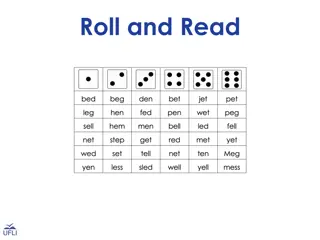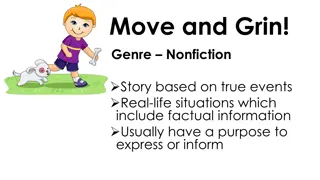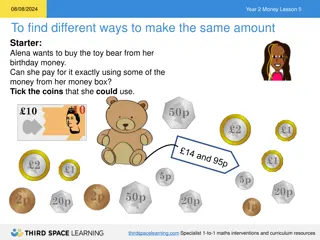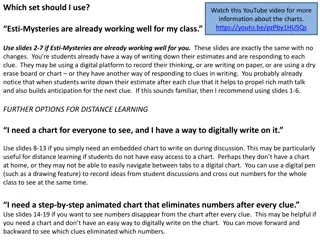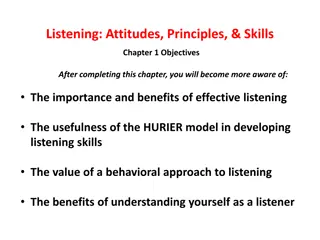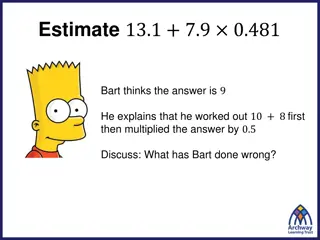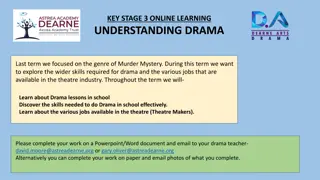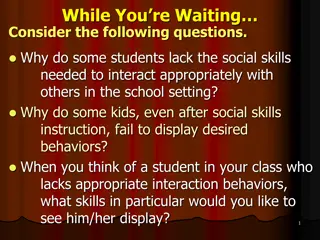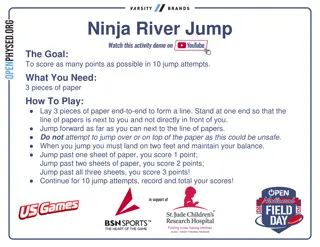Jump Into Fun: Explore Different Ways to Jump and Improve Your Skills
Enhance your jumping skills with a variety of activities like hopping, striding, and jumping over objects. Challenge yourself to beat personal bests, create training programs, and imagine winning Olympic gold. Test your knowledge of jumping terms and improve muscle strength for better performance.
Download Presentation

Please find below an Image/Link to download the presentation.
The content on the website is provided AS IS for your information and personal use only. It may not be sold, licensed, or shared on other websites without obtaining consent from the author. Download presentation by click this link. If you encounter any issues during the download, it is possible that the publisher has removed the file from their server.
E N D
Presentation Transcript
EXPLORE EXPLORE Find a small space. How many different ways can you find to travel? Task: Can you hop over a small object? Can you jump from 2 feet to 2 feet over a line? Can you stride from one line to another? Can you try to make your stride, hop and jump as long as possible? Can you combine a hop, step and a jump together? Mark out a start line. Hop, step and jump and measure the distance you achieve from a standing start with an object or a tape measure. Once you have completed a jump from a standing start, take 3 steps as a run up before the start line and measure your jump. How does beating your personal best make you feel? How can you remain positive if you don t beat your personal best? Parent s Tip! Use your arms to get more momentum with each jump. For more of a challenge, use a small run up or an object to jump over! Can you develop your own practice to help others improve their triple jump? What are the key things to remember to become an expert? The next Olympic Games will be in Tokyo, Japan in 2021. Produce a leaflet advertising the Games and what the host city has to offer, persuading people to visit. Try and use hyperbole, emotive language and rhetorical questions Jonathan Edwards is the current triple jump world record holder. English Challenge! Can you define each of the following words related to jumping in athletics? TRAJECTORY MOMENTUM APPROACH HITCH KICK LOAD LEVER How far is his world record jump? Where did he set this world record? Who holds the women s world record? How many jumps would it take you to jump the length of Jonathan Edwards jump cumulatively? https://www.youtube.com/watch?v=rgHYUDoG8_A
EXPLORE EXPLORE Find a small space. How many different ways can you find to jump? Task: Jump as high as you can Jump from two feet to two feet Jump from one foot to two feet Jump from one foot to the other foot Jump in different directions Jump forwards and backwards Mark out a start line. Swing your arms and jump as far as you can from a standing start, landing on two feet measure your distance with an object or a tape measure if you have one. Once you have completed a jump from a standing start, take 3 steps as a run up before the start line and measure your jump. Work as a family or team to measure each others jumps Can you make your jump as long as possible? Parent s Tip! Use your arms to get more momentum with each jump. For more of a challenge, use a small run up Can you create a training programme to improve your long jump distance? What types of practices could you use to improve your performance? Imagine that you have just won the gold medal at the Olympic Games for long jump. Create a diary extract from the day describing your experience. Top tip try to use similes and metaphors in your diary entry to improve your work Muscle Challenge: How many muscles can you name that are important in long jump? Maths Challenge! The length of the sand pit used in long jump is 9m. The width is 2m. What is the overall area of the sand pit? If the depth of the pit is 0.75m, what volume of sand would you need to fill it? What type of training could you do to improve the strength of these muscles? https://www.youtube.com/watch?v=hY2f a6Q98-k
EXPLORE EXPLORE Find about 10 small objects balls of screwed up paper, rolled up socks, or small soft toys. Spread them out on the floor. Put some in pairs and some on their own. Task: Jump over the paired objects with 2 feet, and the single objects on one foot Find as many different ways of jumping over your objects on 2 feet or 1 foot Can you create a route or circuit for your jumping? Use you objects to make a V shape Start at the narrow end and jump across from one side to the other. Try using 1 foot and 2 foot jumps first. Then just jump 2 feet to 2 feet. See how far along you can jump across your V How did it feel when you jumped further each time you practised this? Add in doing this to music for some extra fun! Use these top tips to help you jump further: Start with your knees bent Swing your arms and reach forwards as you jump Explode up and forwards using your legs and toes to push off Parent s Tip! Start with a narrow V and gradually increase it as your child improves Can you create an instructional poster for practising and improving a standing long jump? Give your instructions to someone in your family and ask them to use to improve their technique Standing Long Jump was last in the Olympic Games in 1912 Can you find out who won the Gold medal and how far they jumped? Can you find out who is the World Record holder now? What other sport does this person play? What is the World Record distance and when was it achieved? Maths Challenge! Measure the distance of your longest jump. Can you write that as metres (m), centimetres (cm) and millimetres (mm)? Which is the best unit of measure to use for standing long jump? Why do you think this is?
EXPLORE EXPLORE Draw out a hopscotch like this to practise your jumping. You can use chalk, tape or squares of paper Start on number 1 Find a small space ideally with a soft landing. How many different ways can you find to jump? Task: How far can you jump? How high can you jump? Can you jump from side to side? Can you jump and turn? Can you jump far, high, right, left, backwards, forwards and repeat? Now add some music to your jumping to make it more fun o Can you jump forwards and sideways onto each number in order? o Can you jump far over the double numbers? o Can you jump high in the air and land carefully on every number or just odds and evens Parent s Tip! Let your child be the teacher! They will love coming up with ideas and telling you what to do. You will be amazes at how creative they are Can you draw out your own hopscotch grid and practise improving your jumping? Look up the rules of hopscotch. Can you teach a member of your family how to play? Invent your own rules for your own hopscotch grid and challenge your family to play Maths Challenge! Draw a clock on the floor with chalk or mark the position of the numbers with small objects Pretend you are the hands of the clock! Start in the middle and jump with 2 feet. Jump to 12 o clock and back Jump to half past and back Jump your way around the clock from 1 12 and back again from 12 - 1 Design Technology Challenge Can you draw around your family s feet? Can you cut the feet out? Put them in a line, toe to heel. Can you jump the length of your family s feet?
EXPLORE EXPLORE Find a safe space. How many different animals do you know that jump, hop or leap? Task: Try out lots of different ways of hopping, jumping and leaping in your space Find 10 small soft objects. You can use you toys if you want Jump OVER them Jump AROUND them Jump BEHIND them Jump IN FRONT of them Can you add some jumping music to make this more fun? Tell your family which jumps you like best. Can you say why? Time to work on landing without any wobbles! Put down a small square of paper make sure it won t slip! Jump ONTO your paper. Jump OFF your paper Parent s Tip! Allow your child to explore lots of different ways of jumping, hopping and leaping. Encourage them to be creative! Top tips for wobble free landings: Land feet apart; Bend your knees; Stretch arms out in front; keep your head up; look straight ahead Understanding the World Did you know this about kangaroos? They can hop quickly on 2 legs, and they can walk slowly on 4 legs They can t walk backwards They can swim! Communication and Language Find out how to play Simon Says Play this with your family using the animals you thought about when you explored your jumping. Simon Says jump like a frog Simon Says hop like a grasshopper What other Simon Says can you come up with together? Can you find out where kangaroos live and any other fun facts about them?


